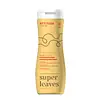What's inside
What's inside
 Key Ingredients
Key Ingredients

 Benefits
Benefits

 Concerns
Concerns

 Ingredients Side-by-side
Ingredients Side-by-side

Water
Skin ConditioningSodium Methyl Cocoyl Taurate
CleansingSodium Lauroyl Sarcosinate
CleansingStearamidopropyl Dimethylamine
EmulsifyingGlycine Soja Seed Extract
Skin ConditioningUlmus Davidiana Root Extract
Skin ConditioningSodium PCA
HumectantPropanediol
SolventPanthenol
Skin ConditioningMentha Piperita Oil
MaskingMelissa Officinalis Leaf Extract
Skin ConditioningUrtica Dioica Extract
AstringentEquisetum Arvense Extract
AstringentMentha Piperita Leaf Extract
Skin ConditioningHydroxypropyl Starch Phosphate
Salvia Officinalis Extract
AntimicrobialPinus Pinaster Leaf Extract
Skin ConditioningOak Root Extract
Skin ConditioningCitric Acid
BufferingVanilla Planifolia Fruit Oil
EmollientZingiber Officinale Root Oil
MaskingCinnamomum Cassia Oil
MaskingEugenol
PerfumingCaprylhydroxamic Acid
Water, Sodium Methyl Cocoyl Taurate, Sodium Lauroyl Sarcosinate, Stearamidopropyl Dimethylamine, Glycine Soja Seed Extract, Ulmus Davidiana Root Extract, Sodium PCA, Propanediol, Panthenol, Mentha Piperita Oil, Melissa Officinalis Leaf Extract, Urtica Dioica Extract, Equisetum Arvense Extract, Mentha Piperita Leaf Extract, Hydroxypropyl Starch Phosphate, Salvia Officinalis Extract, Pinus Pinaster Leaf Extract, Oak Root Extract, Citric Acid, Vanilla Planifolia Fruit Oil, Zingiber Officinale Root Oil, Cinnamomum Cassia Oil, Eugenol, Caprylhydroxamic Acid
Water
Skin ConditioningGlycerin
HumectantSodium Coco-Sulfate
CleansingCoco-Glucoside
CleansingSodium Cocoyl Isethionate
CleansingLauryl Hydroxysultaine
CleansingMoringa Oleifera Seed Oil
EmollientGuar Hydroxypropyltrimonium Chloride
Skin ConditioningCitric Acid
BufferingPanthenol
Skin ConditioningGlyceryl Oleate
EmollientSodium Benzoate
MaskingSodium Chloride
MaskingPCA Glyceryl Oleate
EmollientPotassium Sorbate
PreservativeSodium PCA
HumectantCalendula Officinalis Flower Extract
MaskingNasturtium Officinale Extract
PerfumingTropaeolum Majus Extract
AntimicrobialHexyl Salicylate
MaskingLinalyl Acetate
MaskingMethyldihydrojasmonate
MaskingPentadecalactone
MaskingVanillin
MaskingParfum
MaskingWater, Glycerin, Sodium Coco-Sulfate, Coco-Glucoside, Sodium Cocoyl Isethionate, Lauryl Hydroxysultaine, Moringa Oleifera Seed Oil, Guar Hydroxypropyltrimonium Chloride, Citric Acid, Panthenol, Glyceryl Oleate, Sodium Benzoate, Sodium Chloride, PCA Glyceryl Oleate, Potassium Sorbate, Sodium PCA, Calendula Officinalis Flower Extract, Nasturtium Officinale Extract, Tropaeolum Majus Extract, Hexyl Salicylate, Linalyl Acetate, Methyldihydrojasmonate, Pentadecalactone, Vanillin, Parfum
Alternatives
Ingredients Explained
These ingredients are found in both products.
Ingredients higher up in an ingredient list are typically present in a larger amount.
Citric Acid is an alpha hydroxy acid (AHA) naturally found in citrus fruits like oranges, lemons, and limes.
Like other AHAs, citric acid can exfoliate skin by breaking down the bonds that hold dead skin cells together. This helps reveal smoother and brighter skin underneath.
However, this exfoliating effect only happens at high concentrations (20%) which can be hard to find in cosmetic products.
Due to this, citric acid is usually included in small amounts as a pH adjuster. This helps keep products slightly more acidic and compatible with skin's natural pH.
In skincare formulas, citric acid can:
While it can provide some skin benefits, research shows lactic acid and glycolic acid are generally more effective and less irritating exfoliants.
Most citric acid used in skincare today is made by fermenting sugars (usually from molasses). This synthetic version is identical to the natural citrus form but easier to stabilize and use in formulations.
Read more about some other popular AHA's here:
Learn more about Citric AcidPanthenol is a common ingredient that helps hydrate and soothe the skin. It is found naturally in our skin and hair.
There are two forms of panthenol: D and L.
D-panthenol is also known as dexpanthenol. Most cosmetics use dexpanthenol or a mixture of D and L-panthenol.
Panthenol is famous due to its ability to go deeper into the skin's layers. Using this ingredient has numerous pros (and no cons):
Like hyaluronic acid, panthenol is a humectant. Humectants are able to bind and hold large amounts of water to keep skin hydrated.
This ingredient works well for wound healing. It works by increasing tissue in the wound and helps close open wounds.
Once oxidized, panthenol converts to pantothenic acid. Panthothenic acid is found in all living cells.
This ingredient is also referred to as pro-vitamin B5.
Learn more about PanthenolSodium PCA is the sodium salt of pyroglutamic acid. It is naturally occurring in our skin's natural moisturizing factors where it works to maintain hydration.
The PCA stands for pyrrolidone carboxylic acid, a natural amino acid derivative.
This ingredient has skin conditioning, anti-inflammatory, and humectant properties. Humectants help hydrate your skin by drawing moisture from the air. This helps keep your skin moisturized.
Learn more about Sodium PCAWater. It's the most common cosmetic ingredient of all. You'll usually see it at the top of ingredient lists, meaning that it makes up the largest part of the product.
So why is it so popular? Water most often acts as a solvent - this means that it helps dissolve other ingredients into the formulation.
You'll also recognize water as that liquid we all need to stay alive. If you see this, drink a glass of water. Stay hydrated!
Learn more about Water